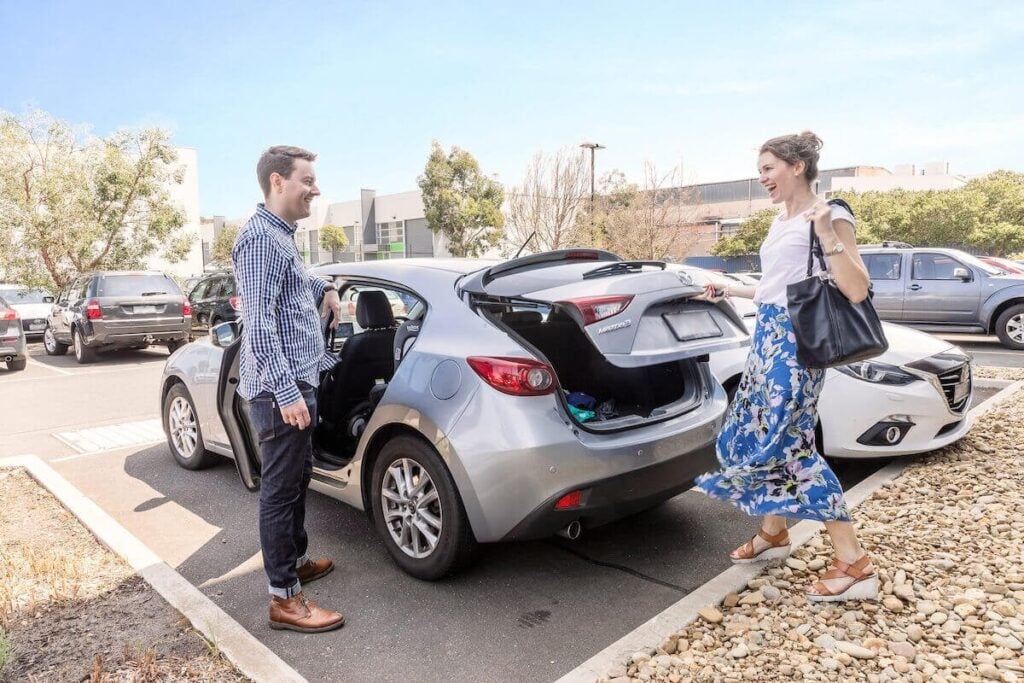iSelect does not compare all providers or policies in the market and not all policies or special offers are available at all times, through all channels or in all areas. Not all policies available from our providers are compared by iSelect and due to commercial arrangements and customer circumstances, not all policies compared by iSelect are available to all customers. Learn more.
Car Insurance in Victoria
With so many people on the road in Victoria from other cars, bikes, pedestrians, and trams, adequate car insurance can provide some much-needed protection as you zip around this bustling state.

What types of Car Insurance are available in Victoria?
Comprehensive Car Insurance
Victorians with Comprehensive Car Insurance have the invaluable peace of mind that comes from knowing they have one of the highest levels of cover. As well as covering all of the things outlined in TPP and TPF&T it helps cover damage to your car in an accident or in an extreme weather event, fire or vandalism. It can also help replace your car if it is damaged beyond repair (‘written off’) after an accident.
Compulsory Third Party (CTP)
As the name suggests, this is compulsory for all Victorian vehicles. It’s included in the cost of your car registration and can pay for death and medical costs in the unfortunate event your car is involved in a serious accident. It can help cover you, your passengers, other road users and pedestrians. Basically, anyone who is injured, or worse, because of an accident with your car.
It’s important to note that CTP doesn’t cover property damage, including damage to your car or other people’s property involved in the accident.
Third Party Property (TPP)
This is the next step up and is often deemed to be the minimum insurance drivers should consider. It helps cover damage to other people’s property caused by your car in an accident. In some limited circumstances, it may also help cover some of your costs if another driver is at fault and they’re not insured. So, if you have TPP insurance and you run into a brand-new Rolls Royce, you probably won’t have to buy a new one out of your own pocket. Phew!
Third Party Fire and Theft (TPF&T)
Another step up is Third Party Fire and Theft insurance. TPF&T helps cover Victorians for damage to another person’s vehicle or property (that’s the ‘Third Party’ bit), and it also helps cover you for any loss or damage to your car resulting from a fire or if it’s stolen. Some policies can also include limited cover should you have a ‘not at fault’ accident and the other driver isn’t insured, but you’ll have to check this with individual providers.
A breakdown of typical inclusions in each policy
| Insurance Type | Injuries to other people | Damage to other people’s car or property | Damage caused by fire or theft | Accidental damage to your own car |
| Compulsory Third Party | Yes | No | No | No |
| Third-Party Property Damage | No | Yes | No | No |
| Third-Party Fire and Theft | No | Yes | Yes | No |
| Comprehensive | No | Yes | Yes | Yes |
Before deciding on a policy, it is important to review the Product Disclosure Statement (PDS) which has detailed information about exclusions, limitations and inclusions.
Helpful Tip:
Driving in Melbourne can be a challenge for those not familiar with dealing with trams and hook turns. So if you’re from out of town a Comprehensive Policy could be worth the added peace of mind!
How much does Car Insurance cost in Victoria?
The cost of car insurance in Victoria can vary for many reasons; the type of cover you choose, the car you drive and where you live can all have an impact.
To give you an idea of costs, here’s the average cost of Comprehensive Car Insurance premiums for Victorian iSelect customers.
Car Insurance in Victoria: your frequently asked questions
Do I need car insurance in Victoria if CTP is included in my registration?
As we said earlier, CTP doesn’t cover any damage to property, yours or anybody else’s. So even if your car is only worth a few thousand dollars, CTP won’t help you if you run into a Ferrari or cause expensive damage to someone’s house or business. You’ll be left to pick up those costs out of your pocket.
It could get ugly and cause long lasting financial damage.
How do I find a suitable car insurance policy in Victoria?
It’s a good idea to begin by working out what level of cover you think would be suitable for you. The section of this article outlining the various covers is a good place to start.
It’s worth thinking of what your cover will cost you now versus how much it could save you, in the event of a claim. Do you really have enough spare money to cover replacing your vehicle, or would you be able to go without? As they say, you notice the value of insurance when you really need it.
So, once you’ve worked out what cover you want, you can start to compare. Different policies offer various options and extras which may be of interest to you. In some cases, these can include:
- Roadside Assistance: Usually an optional extra, it can be very handy having someone to call in the event of a flat tyre or a breakdown.
- Towing: Some policies help with the cost of towing if your car is involved in an accident. Towing can get expensive if you’re a long way from home, so this extra could be helpful.
- Flexible Payment: Not having to fork out for your hefty annual insurance premium all at once can be useful when it comes to budgeting. Some providers let you pay monthly or fortnightly instead of yearly but keep an eye out for additional charges for this payment option.
How can I reduce my Car Insurance premiums?
Some insurers offer certain options which could help reduce your premiums, such as:
- Age-restricted driver: By agreeing that all drivers of your car will be over a certain age (e.g. 25 or 30), some insurers will offer a cheaper premium.
- No-claims bonus: If you don’t claim, your insurer may offer a bonus which builds up over the years. A claim-free insurance history could save you on premiums.
- Personal items cover: Some insurers cover the theft and/or damage of personal belongings from your car, like sunglasses, wallets or laptops.
Another important consideration is the way in which an insurer values your car in the event of a claim. It can usually be ‘agreed value’ or ‘market value’. To make sure you know how your insurer does this, refer to your policy documents and the Product Disclosure Statement (PDS).
Does Victoria have high rates of car theft?
In 2020/21, Victoria alone accounted for over a quarter of Australia’s car thefts, with 12,651 car thefts.1National Motor Vehicle Theft Reduction Council – 1.1 AUS – Motor vehicle theft summary, 2020 to 2021 Some areas are at higher risk for theft than others. Check below to see if you live in one of the top ten areas for car theft.
| Local Government Authority | Motor Vehicle thefts 2020 |
| Hume (City) | 767 |
| Casey (City) | 709 |
| Melbourne (City) | 666 |
| Moreland (City) | 605 |
| Greater Dandenong (City) | 602 |
| Brimbank (City) | 590 |
| Greater Geelong (City) | 562 |
| Wyndham (City) | 538 |
| Darebin (City) | 500 |
| Whittlesea (City) | 421 |
What cars get stolen the most?
Your car doesn’t have to be a highly desirable sporty model to get stolen. In fact, according to carsafe.com.au, some of the most common vehicles stolen in 2020 included: Holden Commodore, Toyota Hilux, Ford Ranger, Holden Captiva, Nissan Pulsar, Ford Falcon and Nissan Navara.2National Motor Vehicle Theft Reduction Council – 3.3 AUS – Top motor vehicle theft targets, 2020. Quite normal, everyday vehicles, in part because there are more on the roads but also because it is easier for thieves to sell their parts or entire cars.
Does Victoria have dangerous roads?
According to ‘Road Trauma Australia’, the 2021 Annual Statistical Summary by the Australian Government Bureau of Infrastructure, Transport and Regional Economics, Victoria had 3.5 fatal car crashes per 100,000 people in 2021.3Bureau of Infrastructure and Transport Research Economics – Road trauma Australia 2021 statistical summary, Table 2.1 – Annual fatality rate per 100,000 population by jurisdiction (page 30) That’s up from 3.2 the previous year.
This isn’t to mention the many more non-fatal crashes that occur every year in Victoria, either. All the more reason you may want to consider car insurance if you’re looking to protect yourself against a costly accident!
So Victoria…are you ready to start comparing policies?
You’ve done the hard work, so now we’ll lend you a hand. Just use our online tool or call 13 19 20 and we’ll help you to compare from our range of car insurance providers.
iSelect does not compare all car insurers or policies in the market. The availability of policies may change from time to time. Not all policies available from iSelect’s providers are compared by iSelect and due to commercial arrangements, area or availability, not all policies compared by iSelect will be available to all customers. Some policies are available only from iSelect’s call centre or website. A number of our participating general insurance brands are arranged by Auto & General Services Pty Ltd ACN 003 617 909 on behalf of Auto & General Insurance Company Limited 111 586 353, both of which are related entities of iSelect Limited. Our relationship with those companies does not impact the integrity of our comparison service. Click here to view iSelect’s range of providers.
iSelect General Pty Limited ABN 90 131 798 126, AFS Licence Number: 334115. Any advice provided by iSelect is of a general nature and does not take into account your objectives, financial situation or needs. You need to consider the appropriateness of any information or general advice iSelect gives you, having regard to your personal situation, before acting on iSelect’s advice or purchasing any policy. You should consider iSelect’s Financial Services Guide which provides information about our services and your rights as a client of iSelect. iSelect receives commission for each policy sold that is a percentage of the premium or a flat fee. Ask us for more details before we provide you with any services.
We'd love to know what you think of our website so we can improve it!
- 1.National Motor Vehicle Theft Reduction Council – 1.1 AUS – Motor vehicle theft summary, 2020 to 2021
- 2.
- 3.Bureau of Infrastructure and Transport Research Economics – Road trauma Australia 2021 statistical summary, Table 2.1 – Annual fatality rate per 100,000 population by jurisdiction (page 30)

.svg)














